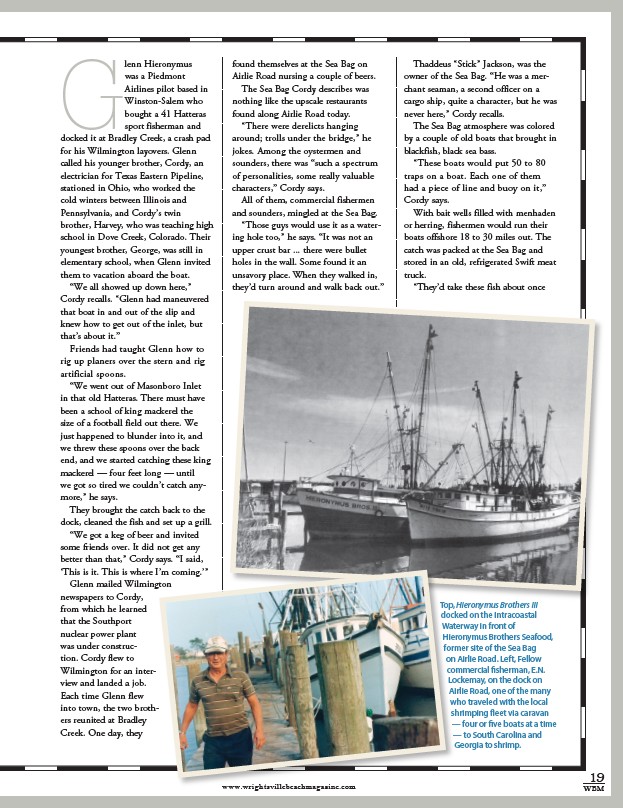
19
www.wrightsvillebeachmagazine.com WBM
Glenn Hieronymus
was a Piedmont
Airlines pilot based in
Winston-Salem who
bought a 41 Hatteras
sport fisherman and
docked it at Bradley Creek, a crash pad
for his Wilmington layovers. Glenn
called his younger brother, Cordy, an
electrician for Texas Eastern Pipeline,
stationed in Ohio, who worked the
cold winters between Illinois and
Pennsylvania, and Cordy’s twin
brother, Harvey, who was teaching high
school in Dove Creek, Colorado. Their
youngest brother, George, was still in
elementary school, when Glenn invited
them to vacation aboard the boat.
“We all showed up down here,”
Cordy recalls. “Glenn had maneuvered
that boat in and out of the slip and
knew how to get out of the inlet, but
that’s about it.”
Friends had taught Glenn how to
rig up planers over the stern and rig
artificial spoons.
“We went out of Masonboro Inlet
in that old Hatteras. There must have
been a school of king mackerel the
size of a football field out there. We
just happened to blunder into it, and
we threw these spoons over the back
end, and we started catching these king
mackerel — four feet long — until
we got so tired we couldn’t catch any-more,”
he says.
They brought the catch back to the
dock, cleaned the fish and set up a grill.
“We got a keg of beer and invited
some friends over. It did not get any
better than that,” Cordy says. “I said,
‘This is it. This is where I’m coming.’”
Glenn mailed Wilmington
newspapers to Cordy,
from which he learned
that the Southport
nuclear power plant
was under construc-tion.
Cordy flew to
Wilmington for an inter-view
and landed a job.
Each time Glenn flew
into town, the two broth-ers
reunited at Bradley
Creek. One day, they
found themselves at the Sea Bag on
Airlie Road nursing a couple of beers.
The Sea Bag Cordy describes was
nothing like the upscale restaurants
found along Airlie Road today.
“There were derelicts hanging
around; trolls under the bridge,” he
jokes. Among the oystermen and
sounders, there was “such a spectrum
of personalities, some really valuable
characters,” Cordy says.
All of them, commercial fishermen
and sounders, mingled at the Sea Bag.
“Those guys would use it as a water-ing
hole too,” he says. “It was not an
upper crust bar ... there were bullet
holes in the wall. Some found it an
unsavory place. When they walked in,
they’d turn around and walk back out.”
Thaddeus “Stick” Jackson, was the
owner of the Sea Bag. “He was a mer-chant
seaman, a second officer on a
cargo ship, quite a character, but he was
never here,” Cordy recalls.
The Sea Bag atmosphere was colored
by a couple of old boats that brought in
blackfish, black sea bass.
“These boats would put 50 to 80
traps on a boat. Each one of them
had a piece of line and buoy on it,”
Cordy says.
With bait wells filled with menhaden
or herring, fishermen would run their
boats offshore 18 to 30 miles out. The
catch was packed at the Sea Bag and
stored in an old, refrigerated Swift meat
truck.
“They’d take these fish about once
Top, Hieronymus Brothers III
docked on the Intracoastal
Waterway in front of
Hieronymus Brothers Seafood,
former site of the Sea Bag
on Airlie Road. Left, Fellow
commercial fisherman, E.N.
Lockemay, on the dock on
Airlie Road, one of the many
who traveled with the local
shrimping fleet via caravan
— four or five boats at a time
— to South Carolina and
Georgia to shrimp.